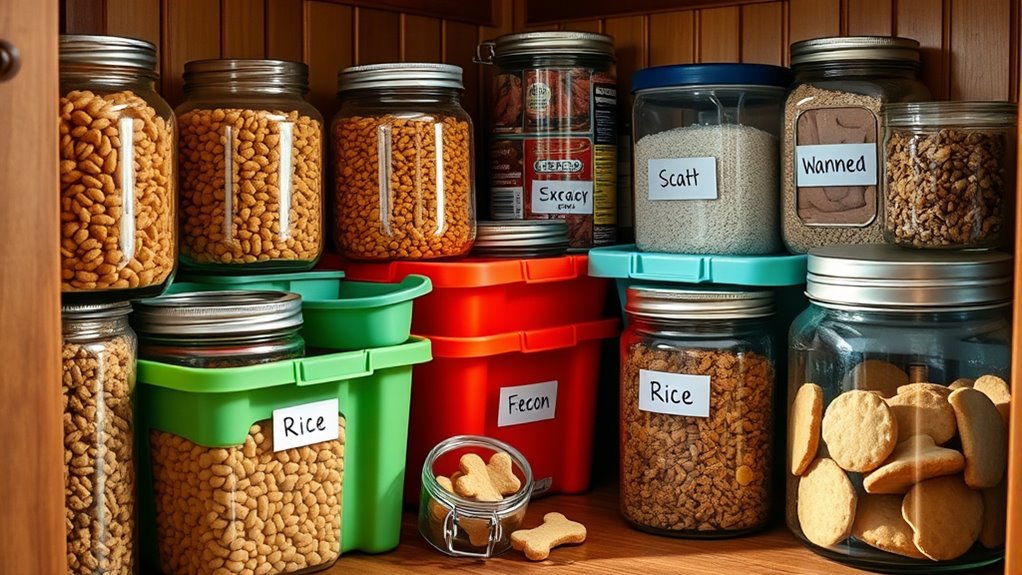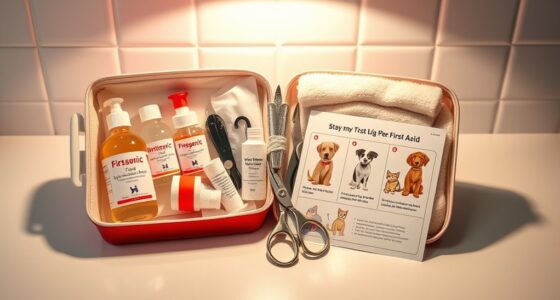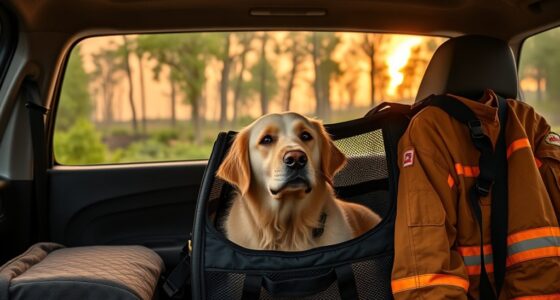To make certain your pet stays safe during emergencies, store long-lasting, nutrient-rich foods like dry kibble and canned options, rotating stock regularly. Prepare homemade meals such as boiled chicken, rice, and vegetables, avoiding harmful ingredients. Also, keep a supply of clean water in durable containers for hydration. Proper storage and planning help your pet stay healthy and comfortable. If you want to discover more tips on effective emergency feeding, keep exploring the options available to you.
Key Takeaways
- Store a sufficient supply of commercial pet food with proper sealing and check expiration dates regularly.
- Prepare homemade emergency pet meals using safe ingredients like boiled chicken and rice, avoiding harmful substances.
- Use airtight containers to store homemade foods for freshness and easy access during emergencies.
- Incorporate raw food options carefully, ensuring balanced nutrition and gradual transition to prevent digestive issues.
- Keep an ample, sealed water supply for pets, replenishing regularly to maintain hydration during emergencies.

During emergencies, guaranteeing your pets are fed can be a critical part of keeping them safe and healthy. When disaster strikes, access to fresh food and water may become limited, making it essential to have a plan for maintaining proper pet nutrition. Stocking up on emergency food supplies ensures you’re prepared to meet your pet’s dietary needs during uncertain times. It’s not just about having enough food; it’s about choosing the right types that can sustain your pet’s health and energy levels over days or even weeks without access to regular supplies.
Ensuring your pets are fed during emergencies is vital for their safety and well-being.
To effectively manage your pet’s nutrition during an emergency, you should consider long-lasting, nutrient-dense foods that don’t require refrigeration or complex preparation. Commercial pet foods, such as dry kibble and canned options, are ideal because they have a long shelf life and are easy to store. When selecting emergency food supplies, check expiration dates and rotate stock regularly to keep supplies fresh. Remember, your pet’s dietary needs vary by age, breed, and health conditions, so choose foods that meet those specific requirements. For instance, puppies, senior pets, or animals with special health issues may need tailored nutrition, which should be factored into your emergency planning.
In addition to commercial foods, homemade options can be useful when supplies run low or if you prefer to prepare your pet’s meals yourself. Simple, nutritious homemade recipes often include boiled chicken, rice, and vegetables, providing a balanced mix of protein and carbohydrates. Ensure that any homemade food is free of harmful ingredients like onions, garlic, or excessive salt. Preparing homemade meals in advance and portioning them into airtight containers can save time during a crisis. Keep in mind, though, that homemade diets may lack certain nutrients found in commercial products, so consult your veterinarian to formulate a safe emergency menu that maintains your pet’s health. Incorporating raw food diets can promote dental health and nutritional variety, but should be carefully planned and introduced gradually to avoid digestive issues.
Water is just as essential as food, so always include a sufficient supply of fresh water in your emergency kit. Proper hydration supports digestion, circulation, and overall well-being, especially when stress levels are high. Store water in durable, sealed containers, and plan for at least a week’s supply per pet. Regularly check and refill your emergency supplies to ensure they’re ready when needed.
Frequently Asked Questions
How Long Can Pet Food Be Safely Stored?
The pet food shelf life depends on its type and storage conditions. Typically, unopened dry kibble can last up to a year, while canned food lasts 1-2 years if stored properly. Once opened, dry food stays fresh for about a month in a cool, airtight container, and canned food should be used within a few days. Keep storage conditions consistent and away from heat or moisture to make sure your pet’s food remains safe.
Are Homemade Pet Foods Nutritionally Complete?
You might think homemade diets can’t match store-bought options, but they can be nutritionally complete if you plan carefully. To guarantee your pet gets all necessary nutrients, consult a vet or pet nutritionist for guidance. Properly balanced homemade diets include proteins, carbs, fats, vitamins, and minerals. With the right recipes, you provide a safe, nutritious meal that supports your pet’s health, even during emergencies or routine feeding.
What Emergency Supplies Are Best for Pets?
When choosing emergency supplies for your pets, prioritize items like enough pet hydration supplies to keep them safe, including water and electrolyte solutions. Have an emergency vet contact list handy for quick access. Also, include familiar food, medications, and comfort items. Preparing these essentials guarantees your pets stay safe and healthy during any crisis, giving you peace of mind knowing you’re ready to handle unexpected situations effectively.
How to Handle Medication Needs During Emergencies?
During emergencies, you should prioritize medication management by keeping a detailed list of your pet’s medications, dosages, and administration schedules. Always have an ample supply on hand, plus extra in case of delays. Make sure you know your emergency vet contacts and nearby clinics. Store medications in a waterproof, easy-to-access container, and consult your veterinarian for advice on alternative options or adjustments needed during crises.
Can Pets Eat Human Emergency Food Supplies Safely?
Pet food and people’s emergency supplies often overlap, but you shouldn’t assume all human foods are safe for pets. You’ll want to check the pet food shelf life and avoid giving pets anything toxic or questionable. In your emergency pet kit, include specially formulated pet foods, and keep human emergency foods separate. Protect your pet’s health by providing appropriate, safe sustenance during crises, and always consult your vet if unsure.
Conclusion
When emergencies strike, having stored pet food and homemade options nearby feels like a comforting embrace, turning chaos into calm. As you reach for that bag of canned food or whip up a quick treat, it’s a reminder that preparation isn’t just practical—it’s a quiet reassurance. In those moments when everything else feels uncertain, your thoughtful planning becomes a small but powerful beacon of safety for your beloved pet, guiding you through the storm.










